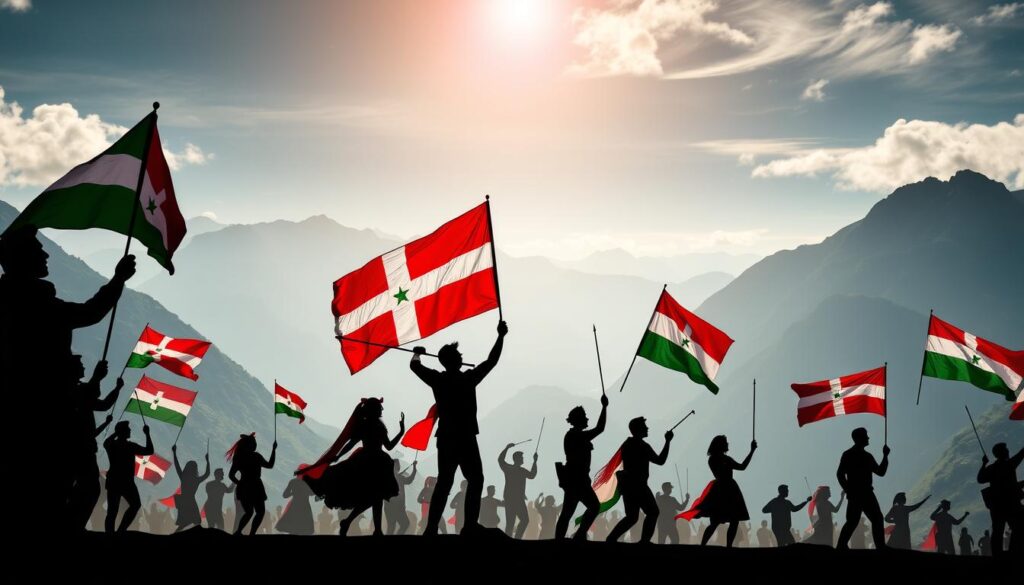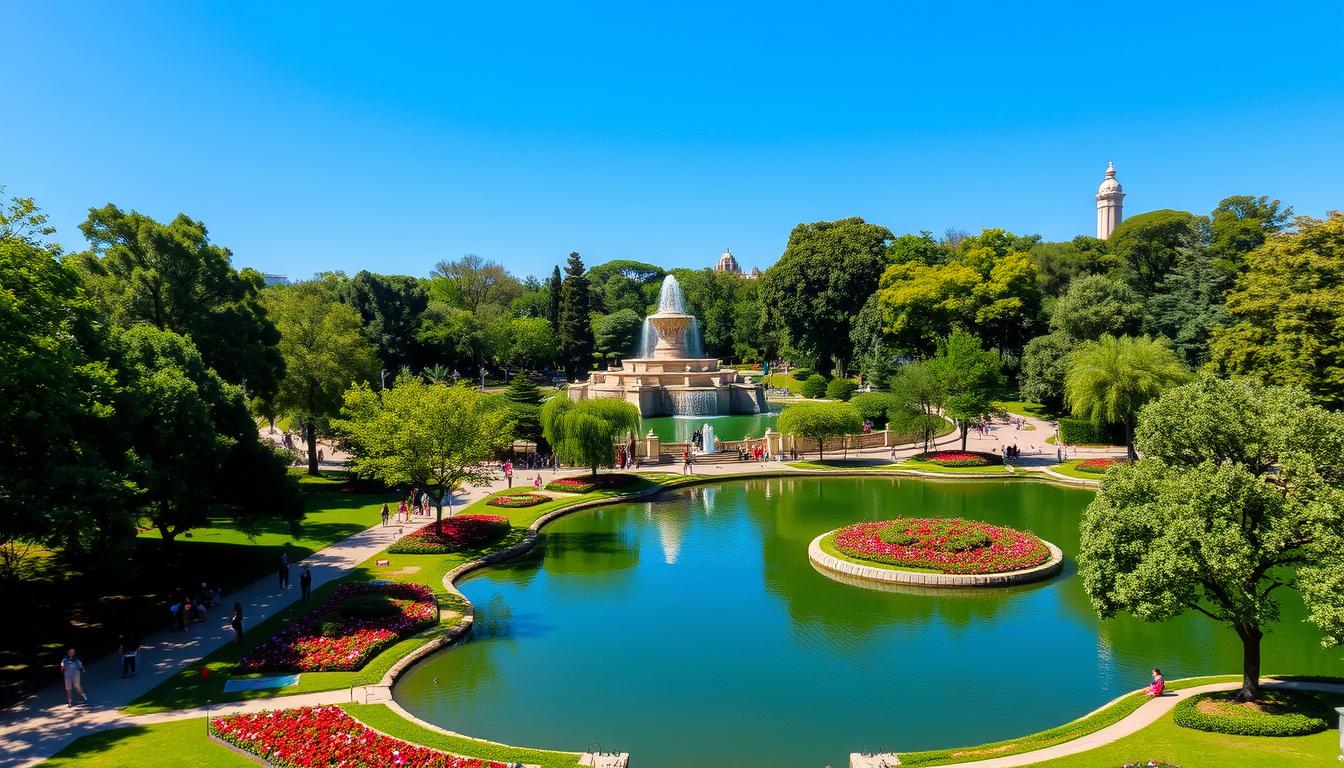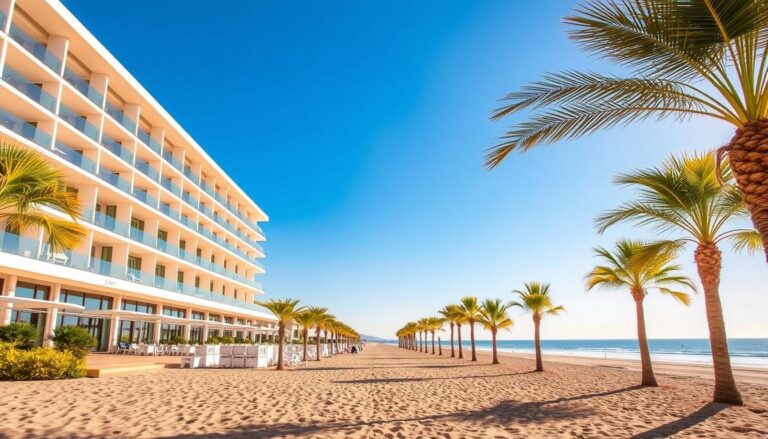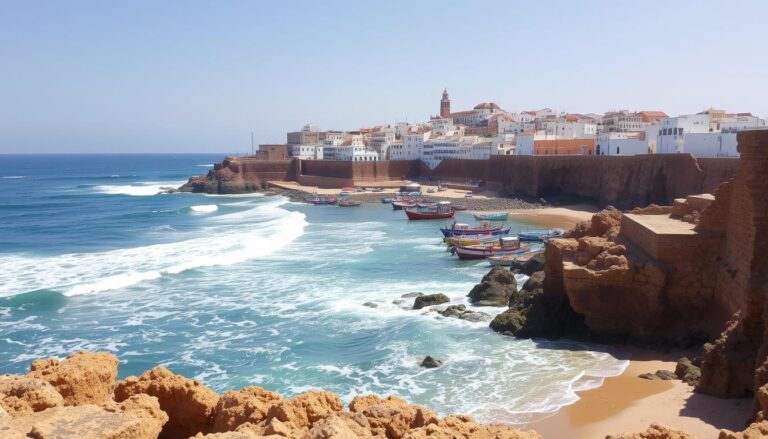Immerse Yourself in the Basque Country: Euskal Herria
At the heart of Barcelona, I felt the spirit of Euskal Herria in Ciutadella Park. This green space tells stories of strength, like the Basque Country’s landscape.
Ciutadella Park is more than a green escape. It shows how city life and nature can connect, like in the Basque Country. Exploring this park is like discovering Euskal Herria – full of surprises and rich history.
Barcelona’s parks reflect the Basque Country’s mix of city and nature. Walking in Ciutadella Park, imagine the Basque Country’s hills and coastlines. This region is where Spain and France meet.
The park is a symbol of preserving culture, like the Basque Country’s efforts to keep its identity. Every corner has a story of strength, creativity, and connection to the earth.
Visiting Ciutadella Park is just the start. The Basque Country invites you to explore its traditions, landscapes, and culture.
Understanding Basque Culture and Heritage
The Basque people live in Euskadi, a region in Europe. They have a rich history that spans thousands of years. Their culture shows resilience, tradition, and a unique identity.
About 850,000 Basques live in Spain. Another 130,000 are in France, and around 170,000 live in communities around the world. Despite many challenges, they have kept their culture strong.
Table of Contents
The Origins of Basque Identity
The Basque identity comes from a long and complex history. Ancient Romans wrote about the Vascones in Navarra. This shows the region’s importance for thousands of years.
The Basques fought off many invaders, like the Visigoths, Franks, and Moors. They kept their culture alive through these battles.
- Oldest known inhabitants of the Iberian Peninsula
- Language isolate: Euskara has no known linguistic relatives
- Maintained cultural distinctiveness through political transformations
Preserving Traditions in Modern Times
Basque culture is still thriving today. In 1978, the region got local autonomy. This helped them preserve and celebrate their culture.
During the Franco regime, Euskara was suppressed. But now, there’s a renewed pride in speaking this unique language.
The Role of Festivals in Basque Society
Festivals are key to keeping Basque culture alive. Events like Aste Nagusia in Bilbao feature traditional music, dance, and community spirit. These celebrations bring people together and keep traditions alive.
- Nine-day festival with concerts and traditional performances
- Drum parades featuring traditional costumes
- Community gatherings that reinforce cultural bonds
Understanding Basque culture means seeing a community that has kept its heritage alive. They have faced many challenges but always adapt while staying true to themselves.
The Basque Language: Euskera
Euskera is a unique language in Europe. It’s more than just a way to communicate. It connects us to a deep cultural heritage that has lasted for centuries.
The Basque language is special in studies. It doesn’t belong to any known language family. This mystery has made linguists from all over the world curious.
Unique Linguistic Features
Euskera has features that make it stand out:
- It has a complex grammar with a unique structure
- It’s not related to Indo-European languages
- Its sounds are different from other languages
- It has a rich way of changing words
Language Revitalization Efforts
Today, Basque communities are working hard to keep Euskera alive. They use schools, media, and cultural events to teach and share the language.
Essential Euskera Phrases for Travelers
Learning basic Euskera phrases can make your trip better. It shows respect for the local culture. Here are some important ones:
- Kaixo – Hello
- Eskerrik asko – Thank you
- Agur – Goodbye
- Mesedez – Please
With about one million speakers in Spain and France, Euskera is still strong. Exploring the Basque region is even more rewarding when you understand this amazing language.
Exploring Basque Cities: Bilbao and San Sebastian
The Basque Country is home to two amazing cities. Bilbao and San Sebastian are cultural treasures. Each city has its own charm and attractions, perfect for those seeking a real experience.
Bilbao’s Architectural Marvels and Cultural Scene
Bilbao has changed from an industrial city to a cultural hub. The Guggenheim Museum is its highlight. Its titanium exterior shows the city’s innovative side.
- World-renowned Guggenheim Museum
- Vibrant arts and cultural scene
- Cutting-edge architectural designs
San Sebastian’s Culinary Delights and Beaches
San Sebastian is a top food destination. It has many Michelin-starred restaurants, like Mirador De Ulia. The city’s beaches and Belle Époque buildings are perfect for food lovers.
| Culinary Highlights | Details |
|---|---|
| Michelin-Starred Restaurants | Multiple top-rated dining experiences |
| Pintxos Culture | Traditional Basque small plates |
| Beach Quality | World-class urban beaches |
Day Trips and Excursions from Major Cities
There’s more to see than Bilbao and San Sebastian. The area has many day trips. You can visit coastal villages, hike in mountains, and see traditional towns.
- Explore nearby coastal villages
- Discover mountain hiking trails
- Visit traditional Basque towns
Bilbao and San Sebastian are great for art lovers, food enthusiasts, and nature fans. They offer a unique look into the Basque Country’s beauty and culture.
The Culinary Wonders of Euskal Herria
The Basque Country is a true food lover’s paradise. Here, old cooking methods meet new ideas. It’s not just about food; it’s a way to show off the region’s spirit and love for life.
Traditional Basque Dishes and Ingredients
Exploring the Basque Country’s food scene starts with amazing local ingredients. You’ll find:
- Fresh seafood from the Atlantic Coast
- Locally sourced meats and vegetables
- Espelette pepper, a signature Basque spice
- Irouleguy wines from regional vineyards
The Pintxos Culture: More Than Just Tapas
Pintxos are the soul of Basque social eating. Unlike traditional tapas, these small dishes are more than food. They’re tiny works of art found in bars all over Euskadi. Each pintxo tells a story of local flavors and traditions.
| Pintxos Type | Main Ingredients | Origin |
|---|---|---|
| Gilda | Olives, Anchovy, Pepper | San Sebastian |
| Txangurro | Spider Crab | Coastal Regions |
| Croquetas | Ham, Bechamel | Urban Basque Areas |
Michelin-Starred Restaurants and Local Favorites
The Basque Country is home to many Michelin-starred restaurants. These places offer top-notch food. From Saint-Jean-de-Luz’s seafood to Bayonne’s fresh market ingredients, you’re in for a treat in Euskadi.
Natural Wonders of the Basque Country
Euskal Herria boasts a stunning landscape from the Pyrenees to the Atlantic coast. The Basque Country is a treasure trove of natural wonders. It offers travelers unforgettable adventures and breathtaking views.
Coastal Landscapes: From Cliffs to Beaches
The Basque coastline is a natural marvel. It stretches for about 15 miles, with the Basque Corniche offering views of fishing villages and cliffs. Biarritz, known as the birthplace of French surfing, has waves that draw surfers globally.
- Scenic coastal trails with panoramic ocean views
- Surfing destinations like Biarritz
- Unique fishing villages along the coast
The Pyrenees: Hiking and Mountain Adventures
The Pyrenees are a paradise for outdoor lovers. With 169 kilometers of hiking trails and 9,500 meters of elevation, there’s much to explore. The Iraty forest, Europe’s largest beech forest, covers 20,000 hectares.
| Hiking Route Characteristics | Details |
|---|---|
| Total Routes | 15 |
| Total Hiking Duration | 65 hours 30 minutes |
| Average Route Length | 10.5 kilometers |
| Highest Peak | Rhune (900 meters) |
Protected Areas and National Parks
The Basque Country values its natural heritage. It has protected areas like the Urdaibai Biosphere Reserve, a UNESCO site. This reserve is home to many bird species, including fish eagles and spoonbills.
- UNESCO Biosphere Reserve
- Rich biodiversity
- Ecological preservation efforts
Basque Arts and Crafts
Exploring Basque culture shows a rich artistic world. It mixes old traditions with new ideas. Euskadi is a great example of this, where artists keep their heritage alive.
Traditional Craftsmanship: Preserving Artistic Roots
The Basque Country is known for its traditional crafts. These crafts show its deep culture. In places like La Bastide-Clairence, artisans make amazing things.
- Ceramic pottery with unique designs
- Intricate textile weaving
- Woodworking that shows great skill
- Metal crafting with historical value
Contemporary Basque Art Scene
Today’s Basque artists are breaking new ground while staying true to their roots. The film industry is a great example of this.
| Film | Achievements | Cultural Significance |
|---|---|---|
| Irati | 4.3 million euro budget | Largest Basque production to date |
| Akelarre | Five Goya Awards | Highlighted Basque mythological themes |
| Errementari | Horror Film Audience Award | Showcased unique storytelling |
Museums and Galleries to Explore
There are many places that celebrate Basque art. Key locations include contemporary art museums in Bilbao and traditional craft galleries throughout Euskadi. These places let you dive into the region’s artistic journey.
Whether you love old crafts or modern art, the Basque Country is full of surprises. It’s a place that inspires and amazes everyone.
Basque Sports and Recreation
The Basque Country is a thrilling place for sports and fun activities. It shows off the region’s rich culture and love for challenges. Here, you can find everything from old games to new adventures.
Traditional Basque Sports: Pelota and Rural Challenges
Jai alai is a top sport in the Basque Country. It’s incredibly fast, reaching speeds of up to 240 kilometers per hour. Players compete in frontons, courts that are 53.3 meters long and 15.2 meters wide.
- Jai alai matches can score between 10 to 40 points
- Professional players peak in their late 20s to early 30s
- Players use custom adhesive tape to protect their hands
Rural Sports: Strength and Tradition
Basque rural sports, or herri kirolak, mix old work skills with competition. These sports turn traditional tasks into amazing athletic feats.
| Sport | Description | Challenge |
|---|---|---|
| Aizkora proba | Wood chopping | Cutting through multiple trunks |
| Harri jasotzea | Stone lifting | Hoisting stones to shoulder height |
| Txinga eramatea | Weight carrying | Transporting 25 kg weights for distance |
Surfing and Outdoor Adventures
The Basque Coast is perfect for surfing. From Hendaye to San Sebastian, you’ll find amazing waves. The area also offers mountain biking, hiking, kayaking, and paragliding.
Whether you want to watch sports or try outdoor activities, the Basque Country is unforgettable. It connects you with its lively culture.
Understanding Basque Politics and Independence Movement
The Basque Country’s politics show a long history of cultural strength and national identity. Euskadi, a region with a strong sense of independence, has faced many challenges. It has worked hard to keep its culture alive.

The journey of Basque independence has seen many important times. From 1959 to 2011, the region went through a long conflict. This conflict deeply shaped its political views.
Historical Context of Basque Nationalism
Basque nationalism started as a way to protect its unique culture. It began in the early 20th century, fighting against Spanish control. Important moments include:
- Resistance against Spanish centralization
- Formation of distinct political identities
- Struggles for cultural and linguistic autonomy
Current Political Landscape
Today, the Basque politics are more complex but still focused on self-rule. Even though full independence is hard, the region has a lot of freedom within Spain.
| Political Indicator | Data Point |
|---|---|
| Language Speakers | 36.2% speak Basque |
| Conflict Duration | 52 years (1959-2011) |
| Total Casualties | Over 1,000 people |
Impact on Tourism and Local Culture
The Basque independence movement has shaped tourism in a special way. Visitors get to see a place with deep-rooted cultural pride and complex stories.
Knowing about Euskadi’s history helps visitors understand its rich culture and strong community spirit.
Planning Your Trip to Euskal Herria
Planning your trip to the Basque Country is key to a great experience. With the right preparation, you can enjoy the region’s attractions and transportation. Bilbao Airport connects to over 30 European cities, making it easy to get there.
The Basque Country has a strong and efficient transport system. High-speed trains link Madrid to Bilbao in under 5 hours, costing about 50 euros. Driving from Madrid to San Sebastian takes around 5 hours, while Barcelona is a 6-6.5 hour drive. Renting a car lets you explore smaller towns like Durango, just 20 miles from Bilbao.
Best Times to Visit
Summer is the best time to see the Basque Country in full swing. San Sebastian welcomes many French tourists during this time. July is especially busy with the San Fermín festival in Pamplona, drawing millions. Plan your visit for coastal activities or cultural events to avoid the crowds.
Accommodation and Local Etiquette
When in Bilbao or San Sebastian, pick accommodations that fit your style. You can find luxury hotels near the Guggenheim Museum or cozy rural guesthouses. Show respect by learning some Euskara phrases. This will help you appreciate the language and culture of this special region in Spain.







